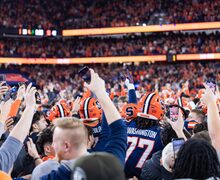After player’s scary concussion, Elmhurst College football team begins using padded helmet caps in hopes of limiting head injuries
Alec Giles lay stiff on his back, arms frozen, covering his face. For about two minutes, he didn’t move. The crowd of just less than 2,000 at Elmhurst College’s Langhorst Field sharply hushed into silence.
“It was a really big hit; you could just hear it,” Elmhurst safety Ryan Johnson said. “And then when you saw his body just do what it did, I think a lot of people were just scared for how he was going to be after that.”
Giles suffered a concussion in that game against Augustana (Ill.) College on Oct. 6 that kept him out for two weeks. The following week, Elmhurst (Ill.) began practicing with Guardian helmet caps. The five-ounce, gel-infused padded caps strap over players’ helmets, distributing the force of collisions and reducing impact by up to 33 percent, according to Guardian’s website.
The Bluejays’ practices have permanently changed. An eerie silence has fallen over team practices. But the players feel safer, hit harder and run more freely, less worried about their own safety. While College Conference of Illinois and Wisconsin rivals have piled up dozens of concussions between practices and games, Elmhurst is nearly concussion-free on the season.
And though the Bluejays cannot yet play games with the helmet pads, they hope that will change as more teams try the equipment created last year.
“There are certain situations or there are certain times where, you never teach people to hit helmet to helmet, but there’s times that it happens,” Elmhurst head coach Tim Lester said.
One such occasion is in regular one-on-one drills, Lester said. A receiver lines up against a defensive back, runs his route and the defender makes a play on the ball and his man. The collision of the two fast-moving players competing for the same space with their helmets clashing is just one part of the larger full-body collision.
Johnson and tight end Ryan Maguire have run into each other nearly every week of practice since Johnson’s freshman season in 2009. But when the two players collided, helmet to helmet, in their first practice with the Guardian equipment, both players bounced back up. Not only did their heads feel fine, but their full-speed collision was also nearly silent.
“Every time it’s always one of us that gets real dazed, and the first time I hit him and I caught it,” Maguire said. “And we kind of looked back at each other and we were like, ‘All right, that didn’t hurt at all.’”
And though Lester said conference opponent North Central (Ill.) College has used the helmet pads for its offensive linemen in practice, they are largely underutilized.
POC Ventures, the company that designed the Guardian in 2011, was created by Erin and Lee Hanson. Their main business is The Hanson Group, which develops self-sealing fuel tank liners for the military.
“The helmet guys are trying by loading the interior of the helmets with padding, but it’s just not enough,” Erin Hanson said in an open letter on the company website.
Lester only bought into the caps after a well-timed email arrived in his inbox just after he’d left a meeting on concussions and their risk to players. He said it was the kind of “standard email” he gets 50 to 70 of daily, but this one just found him at the right time.
Lester forwarded the email to Elmhurst wide receivers coach Kyle Derickson and asked him to investigate. A one-month research process followed in which Lester “read every article (he) could read” on concussions and the Guardian helmets. Lester got samples and ran them by team doctors and trainers.
When they told him they would work, he ordered enough for his whole roster.
“Being a Division-III school, we don’t have a ton of money and they’re not cheap, but when you’re spending money to keep your kids safe preventatively it was a no-brainer,” he said.
Ultimately, Lester and Johnson would like to see more teams use the caps, eventually leading to their use in games. Though they see the change as a long way off, they said it’s an important one that would save plenty of players from injuries.
“There’s concussions going on every week throughout all divisions of football all the way up through the NFL,” Johnson said. “It would save a lot of players from concussions that actually end their career early.”
Lester cited the ongoing evolution of helmets as cause for optimism, even if the changes take on a slightly different form than what his Bluejays use.
“They keep changing helmets and helmets and helmets,” he said. “And I think if they got to that point what they would do is just incorporate them into the helmet and put a soft shell in the middle, and then a hard shell and maybe make the outside soft.”
In the meantime, he’s content to keep his players safer at practice.
Said Lester: “Until they do that, at least there’s something you can do to add some more cushioning to the outside, which just reduces the blow of every hit.”
Published on November 13, 2012 at 11:53 pm
Contact Jacob: jmklinge@syr.edu | @Jacob_Klinger_





